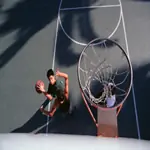In the search for a game-simulating drill, Daryl Smith--known in the basketball world as D-Train--sought to incorporate transition basketball with conditioning, change of direction, jump shots, layups and mental focus.
And of course, it helps if the drill is fun.
This is what D-Train uses. The Position Switch Drill is relatively simple after it's practiced once or twice. It can be used in an individual workout or as a team competition. All you need is a court and a couple of basketballs.
Here's the breakdown:
The Setup
Set three cones out on the court. Cone A will go on the three-point line. Cone B will go on the sideline at half court. Cone C will go on the free-throw line at the other end of the court.
Start the player at the near baseline. They immediately run to Cone A, then cut left and sprint to Cone B. Touch Cone B, then head back to Cone A. Touch Cone A, then sprint across the court to Cone C. Touch Cone C and head back to Cone A.
Once players get back to Cone A after the cross-court sprint, have a teammate pass them the ball. After a maximum of two steps, the player shoots the ball (simulating a jumper in transition). If the player makes the shot, head straight to Cone B and go through the entire course again. When players get back to Cone A for the second time, pass the ball to them and have them drive for a layup.
If the player makes both the jumper and the layup, it's one point. If the player misses the jumper, either start over (if it's an individual drill) or go to the back of the line (if it's a team drill).
The Variations
D-Train, who works with youth, high school, college and professional players, uses the Position Switch Drill both as an individual and team drill for all levels of players.
For an individual, it can get tiring in a hurry.
"I've got college and pro players and I make them do this by themselves," D-Train said. "They will be spent trying to get to five."
D-Train also uses it as a team competition, as he did during the 2010 World Basketball Festival in New York. With about 20 young players in a clinic he was conducting, D-Train split them up into two teams of 10, then put them on opposite sides of the court. The first team to get seven points were declared winners.
Along with all the benefits the drill provides, it's also fun for a young team.
The Purpose
The Position Sprint Drill is one of D-Train's favorites.
"You'd be amazed at how hard it is to run full speed, come to a stop, left foot-right foot, and then shoot," he said. "In reality, 85 to 90 percent of the time in a game, you're not going to be shooting standing still. You're going to be in some type of movement.
"What this drill encourages is transition speed. How fast can you get back on defense, transition to offense, back to defense, and then come back? That might be two possessions. That might happen 30, 40, 50 times a game."
The second part of the process--making a layup--seems easy enough. But not after the grueling workout it required just to get to that point.
"With the layup, can you sustain your concentration enough after you exerted yourself?" D-Train said. "To concentrate and finish and have enough juice to attack the rim and go hard and make a layup."
On this day, one of the teams heated up and won 7-2. But both teams got in a good workout, had a fun competition, and ultimately, improved their game for when it matters most.
"Any time I do training, any type of workout, it's game shot at game speed under game conditions," D-Train said. "That's how you get better."







Discuss This Article